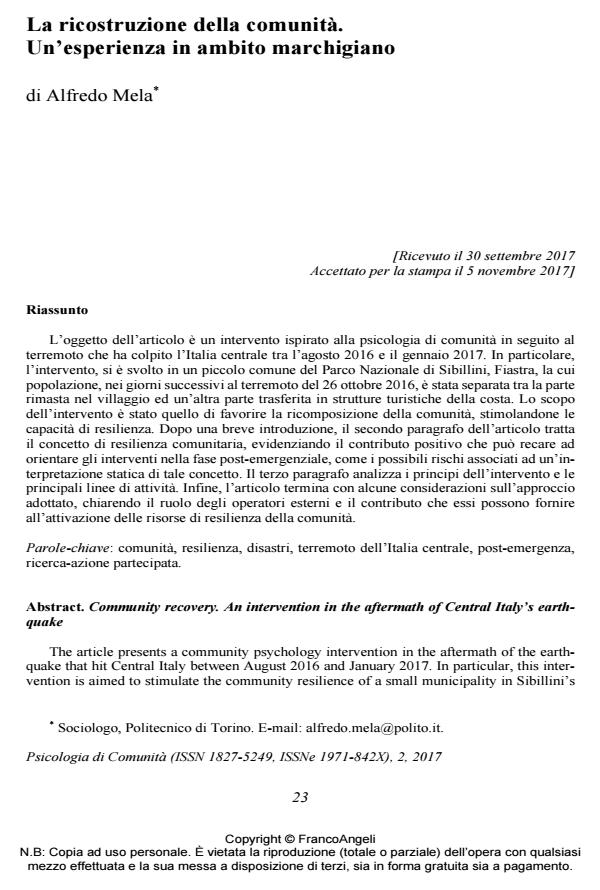Community recovery. An intervention in the aftermath of Central Italy’s earth-quake
Journal title PSICOLOGIA DI COMUNITA’
Author/s Alfredo Mela
Publishing Year 2017 Issue 2017/2
Language Italian Pages 11 P. 23-33 File size 146 KB
DOI 10.3280/PSC2017-002003
DOI is like a bar code for intellectual property: to have more infomation
click here
Below, you can see the article first page
If you want to buy this article in PDF format, you can do it, following the instructions to buy download credits

FrancoAngeli is member of Publishers International Linking Association, Inc (PILA), a not-for-profit association which run the CrossRef service enabling links to and from online scholarly content.
The article presents a community psychology intervention in the aftermath of the earth-quake that hit Central Italy between August 2016 and January 2017. In particular, this inter-vention is aimed to stimulate the community resilience of a small municipality in Sibillini’s National Park, Fiastra, whose population was divided into two parts: one remained in the village; the other was moved to the coasts after the earthquake of October 26, 2016. After a short introduction, the second paragraph of the article discusses the concept of community resilience highlighting the positive contribution that it can make to the interventions for community recovery as well as the possible risks associated with a static interpretation. The third paragraph analyzes the principles of the intervention and the main lines of activity. Fi-nally, the article ends with some considerations on the approach used, clarifying the role of external operators and the contribution they can provide to the activation of community re-silience resources.
Keywords: Community, resilience, disasters, Central Italy’s earthquake, post-emergency, participatory action research.
- Adger W.N. (2000). Social and ecological resilience: Are they related? Progress in Human Geography, 24: 347-364. DOI: 10.1191/030913200701540465
- Aldrich D.P. (2010). Fixing Recovery: Social Capital in Post-Crisis Resilience. Department of Political Science FacultyPublications. Paper 3. Testo disponibile al sito: http://docs.lib.purdue.edu/pspubs/3.
- Berkes F., Ross H. (2013). Community resilience: toward an integrated approach, Society & Natural Resources, 26, 1: 5-20. DOI: 10.1080/08941920.2012.736605
- Berkowitz S., Bryant R., Brymer M., Hamblen J., Jacobs A., Layne C., Macy R., Osofsky H., Pynoos R., Ruzek J., Steinberg A., Vernberg E., Watson P. (2010). The National Center for PTSD & the National Child Traumatic Stress Network, Skills for Psychological Recovery: Field Operations Guide. Testo disponibile al sito:https://www.ptsd.va.gov/professional/materials/manuals/skills_psych_recovery_manual.asp.
- Chicco E., Mela A. (2016). Comunità e cooperazione. Un intervento sul benessere psicologico nel Salvador. Milano: FrancoAngeli.
- Cote M., Nightingale A.J. (2012). Resilience thinking meets social theory. Situating social change in socio-ecological systems (SES) research. Progress in Human Geography, 36, 4: 475-489. DOI: 10.1177/0309132511425708
- Folke C., Carpenter S.R., Walker B., Scheffer M., Chapin T., Rockström J. (2010). Resilience thinking: integrating resilience, adaptability and transformability. Ecology and Society, 15, 4. Testo disponibile al sito: http://www.ecologyandsociety.org/vol15/iss4/art20/.
- Fullilove M.T. (2014). The Frayed Knot: What Happens to Place Attachment in the Context of Serial Forced Displacement. In: Manzo L., Devine-Wright P., editors, Place attachment advances in theory, methods and applications. London: Routledge, pp. 141-153.
- Kirmayer L.J., Sehdev M., Whitley R., Dandeneau S.F., Isaac C. (2009). Commu-nity resilience: models, metaphors and measures. Journal of Aboriginal Health, 5: 62-117.
- Jullien F. (2015). De l’être au vivre. Lexique euro-chinois de la pensée. Paris: Gallimard (trad. it. Essere o vivere. Il pensiero occidentale e il pensiero cinese in venti contrasti. Milano: Feltrinelli, 2016).
- Montero M. (2004). Relaciones Entre Psicología Social Comunitaria, Psicología Crítica y Psicología de la Liberación: Una Respuesta Latinoamericana. Psykhe, 13, 2: 17-28. DOI: 10.4067/S0718-22282004000200002
- Nemeth D.G., Kuriansky J., Reeder K.P., Lewis A., Marceaux K., Whittington T., Olivier T.W., May N.E., Safier J.A. (2012). Addressing anniversary reactions of trauma through group process: The Hurricane Katrina anniversary wellness workshops. International Journal of Group Psychotherapy, 62, 1: 129-142.
- Norris F.H., Stevens S.S., Pfefferbaum B., Wyche K.F., Pfefferbaum R.L. (2008). Community Resilience as a Metaphor, Theory, Set of Capacities, and Strategy for Disaster Readiness, American Journal of Community Psychology 41, 1-2: 127-150.
- Ordine Psicologi del Lazio (2016). Best practices per gli psicologi che operano in contesti di emergenza iscritti all’ordine degli psicologi del Lazio. Testo disponibile al sito: http://www.ordinepsicologilazio.it/risorse/le-best-practices-della-psicologia-dellemergenza/.
- Pellizzoni L. (2017). I rischi della resilienza. In: Mela A., Mugnano S., Olori D., a cura di, Territori vulnerabili. Verso una nuova sociologia dei disastri italiana. Milano: FrancoAngeli, pp. 28-41.
- Reifels L., Pietrantoni L., Prati G., Kim Y., Kilpatrick D.G., Dyb G., Halpern J., Olff M., Brewin C.R., O’Donnell M. (2013). Lessons learned about psychosocial responses to disaster and mass trauma: an international perspective. European Journal of Psychotraumatology, 4. Testo disponibile al sito: http://doi.org/10.3402/ejpt.v4i0.22897.
- Sbattella F., Tettamanzi M., Iacchetti F. (2005). Basic Therapeutic Actions: un modello di intervento psicosociale per le vittime dello tsunami. Nuove tendenze della psicologia, 3, 3: 399-429. http://hdl.handle.net/10807/58311.
- Windle G. (2011). What is resilience? A review and concept analysis. Reviews in Clinical Gerontology, 21, 2: 152-169. DOI: 10.1017/S0959259810000420
- Winstanley A., Hepi M., Wood D. (2015). Resilience? Contested meanings and experiences in post-disaster Christchurch, New Zealand Kōtuitui. New Zealand Journal of Social Sciences 10, 2: 126-134. DOI: 10.1080/1177083X.2015.1066402
- Zautra A., Hall J., Murray K. (2008). Community Development and Community Resilience: An Integrative Approach. Journal of the Community Development Society, 39, 3: 1-18. DOI: 10.1080/15575330809489673
Alfredo Mela, La ricostruzione della comunità. Un’esperienza in ambito marchigiano in "PSICOLOGIA DI COMUNITA’" 2/2017, pp 23-33, DOI: 10.3280/PSC2017-002003